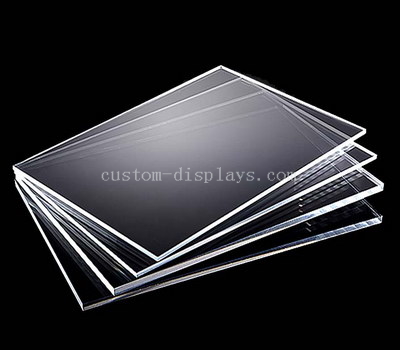Acrylic, also known as plexiglass, is a popular material used in various industries, including display manufacturing. Its high transparency, durability, and lightweight properties make it a preferred material for creating different types of displays. However, when it comes to purchasing acrylic sheets, thickness tolerance range is an important factor to consider.
Acrylic sheets come in two types, extruded and cast. The manufacturing process for these two types of acrylic sheets is different, which leads to differences in their thickness tolerance range.
Extruded acrylic sheets are made by melting acrylic pellets and pushing the molten material through rollers to create flat sheets. Due to the manufacturing process, extruded acrylic sheets have a narrower thickness tolerance range compared to cell cast sheets. The thickness tolerance range for extruded acrylic sheets can be +/- 5% for sheets less than 3mm thick, and +/- 3% for sheets 3mm and thicker.

Cast acrylic sheets, on the other hand, are made by pouring liquid acrylic into a mold and letting it cool and solidify. This process allows for better control over the thickness of the sheet, resulting in a wider thickness tolerance range compared to extruded sheets. The thickness tolerance range for cell cast acrylic sheets can be +/- 10% for sheets less than 6mm thick, and +/- 5% for sheets 6mm and thicker.
To better understand the thickness tolerance range of acrylic sheets, the following table shows the typical thickness range for different thicknesses of both extruded and cast acrylic sheets:
| Thickness (mm) | Cast Acrylic (mm) | Extruded Acrylic (mm) |
|---|---|---|
| 2 | 1.8 – 2.2 | 1.9 – 2.1 |
| 3 | 2.7 – 3.3 | 2.9 – 3.1 |
| 4 | 3.6 – 4.4 | 3.9 – 4.1 |
| 5 | 4.5 – 5.5 | 4.9 – 5.2 |
| 6 | 5.7 – 6.3 | 5.8 – 6.2 |
| 8 | 7.6 – 8.4 | 7.8 – 8.2 |
| 10 | 9.5 – 10.5 | 9.7 – 10.3 |
| 12 | 11.4 – 12.6 | 11.6 – 12.4 |
| 15 | 14.3 – 15.8 | 14.6 – 15.4 |
| 18 | 17.1 – 18.9 | N/A |
| 20 | 19.0 – 21.0 | N/A |
| 25 | 23.8 – 26.3 | N/A |
Note that these thickness ranges are for reference only and may vary depending on the manufacturer.
When purchasing acrylic sheets, it’s important to consider the intended application and the required thickness tolerance range. If the display requires high precision, cast acrylic sheets may be the better choice due to their wider thickness tolerance range. If the display doesn’t require high precision, extruded acrylic sheets may be more cost-effective.
Understanding the thickness tolerance range of acrylic sheets is important when creating displays. Extruded and cast acrylic sheets have different thickness tolerance ranges, and it’s essential to consider these ranges when selecting the appropriate acrylic sheet for your application. For more information on acrylic sheets and displays, visit www.custom-displays.com.
